✕

Column: industry Tag: pesto,food,facts Published: 2024-11-08 10:04 Source: www.mashed.com Author: LAUREN CORONANOV. 6
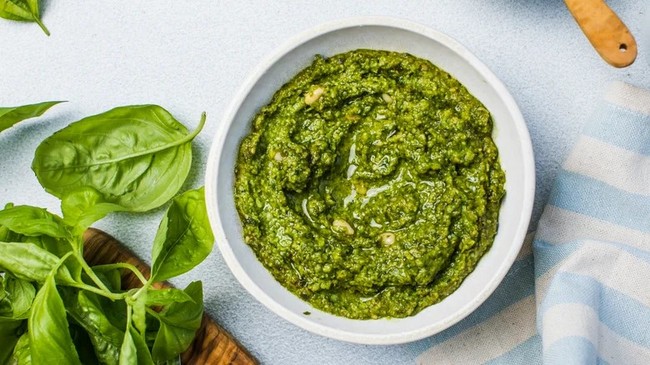
Gorchittza2012/Getty Images
With its distinctive flavor of basil and pine nuts, good pesto is transformative. But there's also so much subpar pesto out there, whether store-bought or made using recipes found online. This might leave you wondering why it is that pesto always tastes better at a restaurant. If your own attempts to make it at home haven't lived up to your expectations, it might be time to find out why.
It's perfectly possible to make restaurant-quality pesto at home, you just need to know how. Because it's a fairly simple recipe, it's all about the quality of ingredients you use and attention to detail. To make it like they do in restaurants, you don't want just any basil — you need fresh Genovese basil. And, the best pesto will be made with a high-quality extra-virgin olive oil, not just whatever was reasonably priced at the store. You just don't get this kind of attention to detail from jarred pesto. Nor does the average person put this much effort into making a great pesto at home.
It doesn't have to be that way, though. Armed with the knowledge of how to make restaurant-quality pesto, you can elevate your dinners like never before. Whether you stir it through pasta, drizzle it over mushrooms on toast, or just spoon it straight into your mouth, you won't believe the results. Once you know how much effort goes into restaurant pesto, maybe you'll just decide to eat out instead.
Restaurant-quality pesto is made using fresh Genovese basil
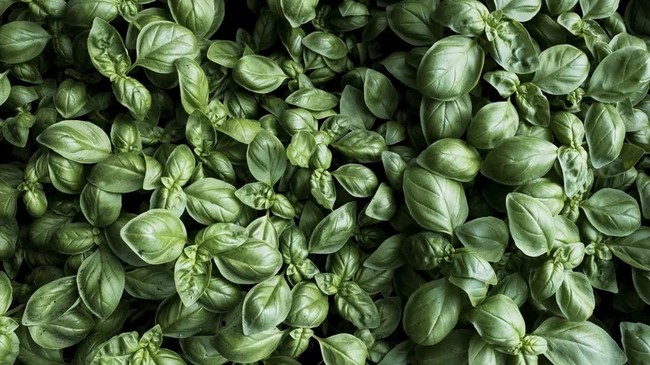
Mint Images/Getty Images
For the best pesto, you need great basil. Restaurant-quality pesto is made using fresh Genovese basil. The plant is so-called because it originates in the Genoa region of Italy. Some chefs might go as far as importing basil from Genoa and its surroundings, but you can also find it grown closer to home.
Genovese basil has a sweet yet peppery flavor and is highly aromatic. It gives you that classic basil flavor you expect from pesto, so you shouldn't go for any other variety. Luckily, it's popular, so most basil you'll find in grocery stores and at farmers markets are of the Genovese variety. But it pays to double-check. There is also Basilico Genovese that's grown according to Denominazione di Origine Protetta (DOP) rules. This means it has been grown in the Genovese region and under certain conditions (such as in a greenhouse and without pesticides). This is particularly sought-after, so serious chefs might buy it if they aren't worried about airmiles. However, chefs in Italy are more likely to use it than chefs in the U.S.
Of course, it should go without saying, but only fresh basil is used for great pesto. Dried basil wouldn't give you remotely the same results. Frozen basil would lack the flavor needed for excellent pesto and might impart a strange texture.
Chefs use fresh, quality garlic to make pesto
Simpleimages/Getty Images
Garlic shouldn't be overwhelming in pesto but it's an important element. Chefs always use fresh, raw garlic — not powdered, frozen, jarred, roasted, or sautéed. It might be the sort of ingredient you're not used to paying all that much attention to, but you'll need to change that for perfect restaurant-quality pesto.
Make sure your chosen garlic is firm, not soft or shriveled. Once peeled, ensure there aren't any brown spots and that it hasn't sprouted. Garlic is an essential element of pesto, but when it's raw, it can easily overpower the dish. Some chefs will only use young spring heads of garlic when they're available. Young garlic is milder and won't give too much punch to your pesto. If it's not available, just make sure not to use too much. An average pesto recipe will only use a single clove. However, you can expect to use more if you're making a big batch.
Pesto from restaurants may be made using Italian pine nuts
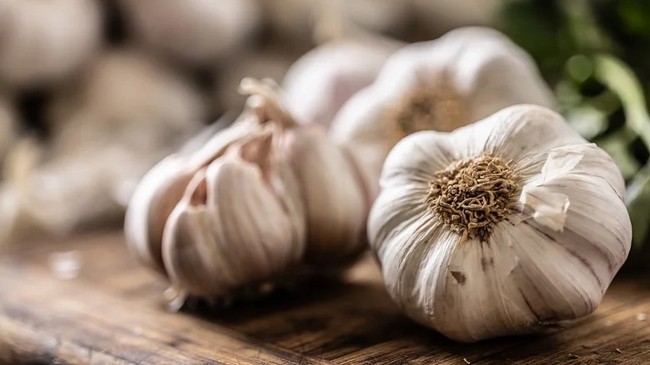
Westend61/Getty Images
When you make pesto at home, it's easy to grab whatever ingredients you have on hand. You might throw in some basic pine nuts or even swap them for something like walnuts or almonds. However, professional chefs who make restaurant-quality pesto are careful about how they source their ingredients, and a part of that is using authentic Italian pine nuts.
You can notice the difference when you use Italian pine nuts. They have a sweeter taste and more easily break down into a smooth, creamy paste. This subtle difference can make restaurant pesto taste better and have a nicer consistency than average homemade versions. Italian pine nuts are more expensive and harder to find, which is why many people skip them. But for chefs aiming for the best flavor, they're worth it.
So, if you've ever wondered why your homemade pesto doesn't quite match what you get at a restaurant, the type of pine nuts might play a part. It might seem picky, but it's that kind of attention to detail that takes recipes from good to incredible. If you're up for a splurge, try Italian pine nuts in your own pesto — you might be surprised at the difference.
High-quality extra-virgin olive oil makes restaurant pesto shine
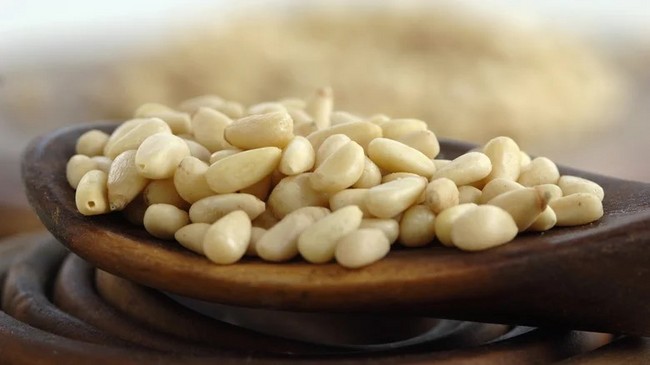
Fabio Balbi/Shutterstock
The olive oil you choose for pesto can make or break its flavor — and chefs know this. Great quality extra-virgin olive oil adds richness and depth, while a low-quality oil can leave it tasting flat or bitter. Not to mention that a lot of low-quality olive oil is actually rancid. Chefs often avoid buying olive oil from the supermarket because it may be rancid due to age or improper storage. So, that's something to think about when sourcing yours.
Ligurian olive oil, which comes from the region of Liguria in Italy, is often considered the gold standard for classic pesto. It has a mild, fruity taste that lets the basil, garlic, and cheese in pesto shine without overpowering them. It doesn't have to be Ligurian, though — it just needs to be high-quality. Olive oil preference can vary from person to person, so don't be afraid to experiment. Some people like a stronger, peppery oil, while others prefer something mild and buttery. Try tasting a few different oils on their own. If an olive oil doesn't taste good by itself — if it's too bitter, metallic, or just unpleasant — it won't make great pesto, either.
Restaurant pesto uses good Parmesan or other hard cheeses

Alessio Orru/Shutterstock
Cheese is an important ingredient in pesto, but you might not realize that the type of cheese used matters. Parmigiano Reggiano — also known as Parmesan — is the most common option. But chefs often use another Italian hard cheese or a mixture. The flavor difference might be relatively subtle but it will impact the finished sauce.
Parmigiano has a mild, nutty sweetness to it. Sure, it adds plenty of rich umami notes, but it won't overwhelm the dish. The other cheese that's commonly used in good pesto is Pecorino Sardo — or preferably Pecorino Fiore Sardo. This is a type of hard cheese made from sheep milk from the Italian island of Sardinia. The Fiore Sardo version uses raw milk and is made using traditional practices — it's considered the gold standard of Sardinian Pecorino. It differs from Pecorino Romano, which is made using sheep milk but to a different recipe, resulting in a sharper, tangier cheese. Pecorino Romano isn't the right choice for pesto and shouldn't be used interchangeably with Pecorino Sardo.
In restaurants, you might find chefs using a mixture of Parmigiano Reggiano and Pecorino Sardo to get the perfect balance of flavors. They're also likely to choose their cheeses carefully, picking quality options rather than just whatever happens to be at the store.
Chefs add just the right amount of salt to pesto
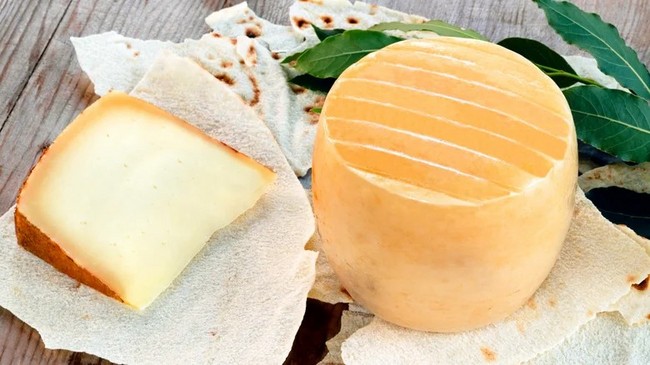
By Marion C. Haßold, Www.marionhassold.com/Getty Images
One reason restaurant pesto often tastes better than homemade is that chefs are good at adding just the right amount of salt. Instead of blindly following a recipe, they taste and adjust as they go. This helps them find the perfect balance, which can be tricky to get right.
Salt enhances pesto's flavor, but too much can ruin it. Chefs understand this and take care not to overpower the delicate balance of ingredients. Home cooks often forget that the cheese in pesto is already salty. Adding too much more salt on top of that can tip the scales, making your pesto too salty. It's one of the common mistakes people always make with pesto.
Instead, try following the chef's approach. Add a small amount of salt at first — coarse sea salt is a perfect option for pesto — and then taste the mixture. If it's lacking something, throw in a little more until it tastes right. A good pesto should have a balanced blend of flavors where nothing overpowers the other ingredients. Chefs have the skills to pull this off, which is why restaurant pesto is so good. But with some care and lots of practice, you can pull it off at home, too.
Toasting pine nuts brings out their flavor for restaurant-quality pesto

Lauripatterson/Getty Images
Toasting pine nuts is a simple step that can make a big difference when you're crafting pesto. Raw pine nuts are mild, but when you toast them, their natural oils release, bringing out a warm, nutty flavor that adds depth to the finished dish. That's why you should always toast pine nuts for pesto. Not every recipe calls for toasting but it's a simple step that's worth the small amount of time and effort for the payoff in flavor.
There are a few ways to toast pine nuts. One of the easiest methods is to use a dry skillet on the stovetop. To toast them this way, spread them in a single layer in the skillet and place it over medium heat. Stir frequently to ensure the nuts toast evenly and don't burn. They're ready when you see them start to turn golden brown and smell fragrant.
You can also toast pine nuts in the oven. Spread them on a baking sheet in a single layer and bake at 375 degrees Fahrenheit for about 5 to 10 minutes, stirring every few minutes. Keep an eye on them, as they can go from golden to burnt quickly. The final option is to microwave them. To do so, spread them on a microwave-safe plate or dish and nuke them on high for 1 minute. Remove them and stir. Then, cook them in 30 second bursts until golden. Always let your pine nuts cool before using them in pesto.
Restaurant-quality pesto may be made using a mortar and pestle
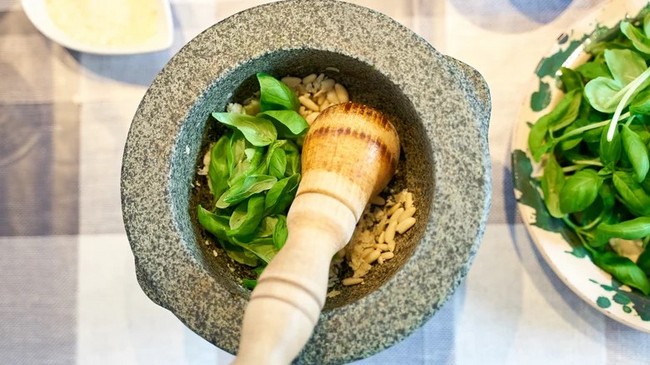
marako85/Shutterstock
The most authentic way to make pesto is by using a Genovese mortar and wooden pestle. This traditional method involves crushing the ingredients by hand. If you go to a small Italian restaurant that prides itself on great pesto, it might be made in this way. But why is it better?
Well, using a mortar and pestle gives you more control over texture and helps break down the basil leaves in a way that preserves more of their aromatic and flavorful compounds. That's hard to match with other tools. Sure, it takes longer, but it's worth it for the texture and taste. The grinding motion gently breaks down the basil leaves without heating them, which helps preserve their flavor and means they don't oxidize as quickly.
However, not every chef has the time to make pesto this way, especially in busy kitchens or when cooking in large batches. Using a mortar and pestle can be time-consuming, so even though it's authentic, many chefs rely on food processors to save time. A food processor may not produce the exact same texture, but it can still make excellent pesto. If you have the tools, we'd recommend trying this method. That said, it isn't essential for great pesto.
Some chefs chop their ingredients by hand
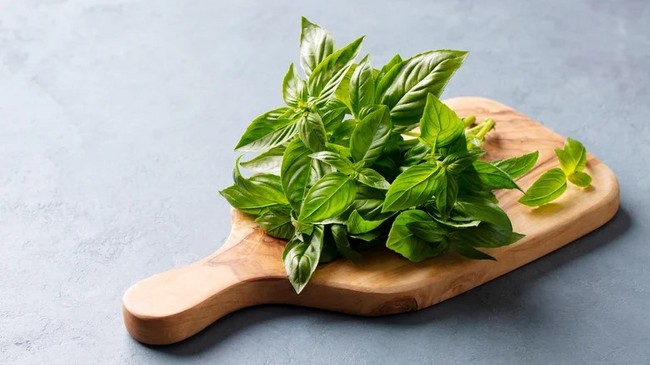
Anna_Pustynnikova/Shutterstock
We've already mentioned that a Genovese mortar and pestle is the most authentic way to make pesto. However, if you want to try another alternative to using a food processor or blender is chopping the ingredients by hand. When you blend or process this sauce, it often turns out as a paste, but actually restaurant-quality pesto often has more texture to it.
Using a knife to chop pesto ingredients is a pretty authentic method that's even the go-to of some Italian grandmas — an important seal of approval. Although it's a little time-consuming for restaurants who use a lot of pesto, when it's used sparingly in dishes, the hand-chopped method can work for chefs. Since they prep a lot of ingredients, they're much quicker at chopping than the average home cook, so making pesto this way can be faster than with a mortar and pestle.
To make it this way, you simply chop the basil, pine nuts, and cheese as finely as possible, mix them with oil and salt, and you're good to go. The texture is chunkier than you might be used to but the results are delicious.
Pesto from a restaurant is never cooked

Ethan Miller/Getty Images
There are many ways to cook with pesto and integrate it into dishes. However, at restaurants, pesto is never cooked. It's used in hot dishes but cooking it ruins the flavor. So, if you want to achieve restaurant-quality results, keep it fresh.
The reason for this is that cooking pesto oxidizes it. When cooked, it turns brown and loses much of its flavor. It's just not the best way to enjoy this usually flavorful and aromatic sauce. Instead, pesto should be used as a fresh dressing. Whether drizzled over meat, used in salads, or mixed with mayo in sandwiches, you don't need to cook pesto to use it in your meals.
"But what about pesto pasta?" You might be asking. The fact is, pesto is never heated with cooked pasta. Rather, you stir room temperature pesto into cooked pasta and serve it like that. If it isn't saucy enough, you can add some of the pasta cooking water. But that's it — no cooking required. The heat of the cooked pasta is enough to make the finished dish warm.
When paired with pasta, chefs know which shapes to choose
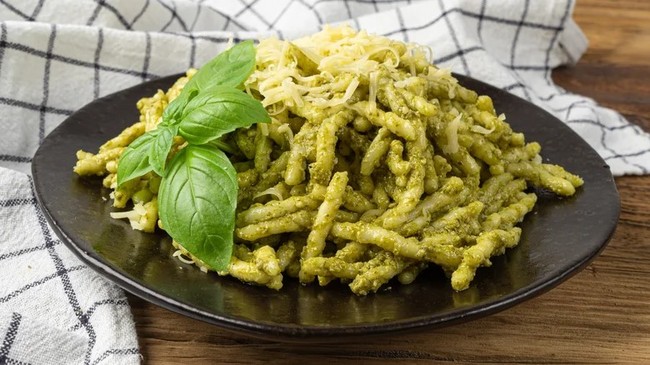
Ermak Oksana/Shutterstock
Did you know that the type of pasta you pair with pesto can make a difference? You might think that whatever shape you have in your pantry will be just fine, but chefs know the best types to use. And this can make restaurant-quality pesto pasta stand out from homemade options.
Pesto is thick and oil-based, so it doesn't cling to pasta in the same way a creamy or tomato-based sauce would. Certain types of pasta are better at catching the pesto, making sure you get a balanced mix of sauce and noodles in each forkful. That's why it's important to find the best pasta to pair with pesto sauce.
Traditionally, Italians match pesto with pasta shapes like trofie and trenette. Trofie is a small, twisted pasta from Liguria, the same region where pesto originated. Its spiral shape catches the sauce perfectly. It holds onto the sauce rather than letting it slide off. Trenette is similar to linguine, and is another great option because its flat shape gives the pesto a surface to grip onto. Aside from trofie, other spiral shapes work well with pesto, such as gemelli and casarecce. But if you don't have access to these types of noodles, even just fusilli works well.
Traditionally, pesto doesn't contain lemon — but some chefs add it

Anna Mardo/Getty Images
A traditional Genovese pesto recipe only contains basil, pine nuts, cheese, olive oil, and salt. Lemon doesn't make the grade. However, some chefs add it. This can make it hard to recreate your favorite restaurant-quality pesto. Depending on the chef, it either may or may not contain lemon, so you might have to experiment to find the results you prefer.
Lemon is at the center of a bit of a debate in the pesto world. Classic recipes don't contain it. Some chefs say that if lemon should be in pesto, it would be in the traditional Genovese recipe. Others say that all recipes are a jumping off point, and just because a recipe is traditional, it doesn't mean that it's perfect. For some, the brightness that lemon brings provides contrast to the heavy umami notes from the other ingredients. It may also be down to the ingredients you have access to. Maybe you don't need lemon when you have top-notch Parmesan or basil grown in rich Italian soils. But if your ingredients aren't up to scratch, the lemony notes might cover up some issues.
But how should you add the lemon? Of course, lemon juice is the obvious choice. Just a little squeeze of lemon can lift a whole batch of pesto. Some also like to add lemon zest, for its rich flavor that comes without the sourness of lemon juice.
Chefs experiment and know when to break the rules
Westend61/Getty Images
We've gone over the rules of classic pesto, but now it's time to learn to break them. Chefs learn the fundamentals of cooking in part so they can figure out how to subvert them while making dishes that taste amazing. They aren't afraid to experiment and let go of the so-called rules when it's called for.
For instance, there are numerous types of pesto beyond classic basil pesto. You might already be familiar with the red version of pesto, but there are way more options. You can make it with arugula, wild garlic, spinach, and so much more. Chefs might choose to use other types of nuts in place of pine nuts to suit the flavor profile of a particular dish.
A good chef will know when to stick with the classics and when to mix things up, depending on the dish they're making and what other ingredients go with it. This is trickier to learn than following a recipe or a classic formula. But if you're willing to put the time in, you'll make a great homemade pesto just like the pros.
Previous:Mistakes Everyone Makes With Mince Pies
Next:New Krusteaz Batters Offer Stress-Free Baking With Sweet Results
Hot key words
Hot Products
Popular Vendors